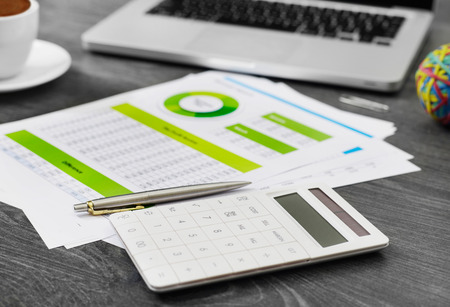1. Understanding Estimated Taxes and Who Needs to Pay Them
If you’re self-employed in the United States, understanding estimated taxes is essential for keeping your finances on track and staying out of trouble with the IRS. This section breaks down what estimated taxes are, why they matter for self-employed individuals, and how the rules differ from traditional employees.
What Are Estimated Taxes?
Estimated taxes are quarterly tax payments made to the IRS throughout the year, rather than paying all your taxes at once during tax season. These payments cover not only income tax but also self-employment tax, which includes Social Security and Medicare contributions.
Why Do Self-Employed Individuals Have to Pay Estimated Taxes?
When you work as a traditional employee, your employer withholds federal income tax, Social Security, and Medicare taxes from every paycheck. But if you’re self-employed—whether as a freelancer, independent contractor, or small business owner—no one automatically withholds these taxes for you. Instead, it’s up to you to estimate your annual tax liability and pay it in four installments during the year.
Comparison: Employee vs. Self-Employed Tax Withholding
| Tax Responsibility | Traditional Employee | Self-Employed Individual |
|---|---|---|
| Who Withholds Taxes? | Employer | You (the taxpayer) |
| How Often Are Taxes Paid? | Every paycheck | Quarterly (estimated payments) |
| Types of Taxes Withheld/Paid | Income Tax, Social Security, Medicare | Income Tax, Self-Employment Tax (Social Security & Medicare) |
Who Needs to Pay Estimated Taxes?
You generally need to pay estimated taxes if:
- You expect to owe at least $1,000 in federal tax for the year after subtracting your withholding and refundable credits.
- You expect your withholding and credits to be less than the smaller of 90% of your total tax for this year or 100% of your total tax shown on last year’s return (special rules apply for higher incomes).
- Your income isn’t subject to automatic withholding—such as earnings from freelancing, gig work, or running your own business.
Key Takeaways for the Self-Employed
- If you’re earning income outside of a regular job where taxes aren’t withheld, you’ll likely need to make estimated tax payments.
- The IRS expects these payments on a quarterly schedule: typically April, June, September, and January of the following year.
- Poor planning can lead to penalties and interest charges if you underpay or miss deadlines.
2. Calculating Your Estimated Tax Payments
Step 1: Estimate Your Projected Income
Start by figuring out how much money you expect to make this year from your self-employment activities. Look at your past income if you’ve been in business for a while, or make an educated guess based on contracts, clients, or sales you expect. Remember, this should be your gross income—before any expenses are deducted.
Example Table: Projected Income Breakdown
| Source of Income | Expected Amount ($) |
|---|---|
| Freelance Writing | 18,000 |
| Online Store Sales | 22,000 |
| Consulting Services | 10,000 |
| Total Projected Income | 50,000 |
Step 2: Figure Out Allowable Deductions and Adjustments
The IRS allows you to subtract certain business expenses from your gross income to arrive at your net earnings. Common deductions include home office expenses, internet costs, supplies, mileage, advertising, and insurance. Add up all the allowable deductions to get a more accurate picture of your taxable income.
Example Table: Deduction Estimates
| Deduction Type | Estimated Amount ($) |
|---|---|
| Home Office Expense | 2,500 |
| Supplies & Equipment | 1,200 |
| Mileage/Travel Expenses | 800 |
| Internet & Phone Bills (business portion) | 600 |
| Total Deductions | 5,100 |
Step 3: Calculate Your Net Earnings from Self-Employment
Your net earnings are simply your projected total income minus your estimated deductions. For example:
- Total Projected Income: $50,000
- Total Deductions: $5,100
- Net Earnings: $44,900
Step 4: Determine Your Taxable Self-Employment Income and Tax Rate
If your net earnings from self-employment are $400 or more, you must pay self-employment tax (Social Security and Medicare) as well as regular income tax. The self-employment tax rate is 15.3% (12.4% for Social Security and 2.9% for Medicare). In addition to self-employment tax, use the IRS tax tables to estimate your federal income tax liability based on your filing status and other sources of income.
Quick Calculation Example:
- Net Earnings: $44,900
- Self-Employment Tax (15.3%): $6,869.70
Add this to your estimated federal income tax for the total tax obligation.
Step 5: Divide Your Total Estimated Tax Into Quarterly Payments
The IRS expects self-employed individuals to pay their taxes quarterly using Form 1040-ES. Take your total annual estimated tax and divide it by four to find out what you owe each quarter.
| Quarter Due Date* | Payment Amount ($) |
|---|---|
| April 15 (Q1) | $X,XXX* |
| June 15 (Q2) | $X,XXX* |
| September 15 (Q3) | $X,XXX* |
| January 15 (Q4 of previous year) | $X,XXX* |
*Insert your actual calculated payment amount per quarter.
*If the due date falls on a weekend or holiday, the deadline shifts to the next business day.
Your Checklist for Calculating Estimated Taxes:
- Add up all expected sources of self-employment income.
- Total up allowable business deductions.
- Subtract deductions from income to get net earnings.
- Calculate both self-employment and federal income taxes owed.
- Divide your annual total by four for quarterly payments.
This step-by-step approach will help ensure you’re estimating correctly—and avoid surprises come tax season!

3. When and How to Make Your Quarterly Payments
Understanding the IRS Payment Schedule
If you’re self-employed in the United States, you’re usually required to make estimated tax payments four times a year. The IRS sets specific deadlines for these quarterly payments. Missing a deadline can result in penalties, so it’s important to stay on top of them.
| Payment Period | Due Date |
|---|---|
| January 1 – March 31 | April 15 |
| April 1 – May 31 | June 15 |
| June 1 – August 31 | September 15 |
| September 1 – December 31 | January 15 (of the following year) |
Tips for Keeping Track of Deadlines
- Set Calendar Reminders: Add all four payment dates to your digital calendar with alerts one week before each due date.
- Create a Tax Folder: Keep all tax documents and payment confirmations in one folder—digital or physical—for easy reference.
- Use IRS Tools: The IRS website offers an Estimated Tax Payment calendar and email reminders you can sign up for.
- Plan Ahead: Consider setting aside money from each client payment, so you’re always ready when quarterly taxes are due.
How to Pay Your Estimated Taxes
Online Payment Options
- IRS Direct Pay: Pay directly from your bank account at IRS Direct Pay. There are no fees and payments are processed quickly.
- EFTPS: The Electronic Federal Tax Payment System (EFTPS.gov) lets you schedule payments ahead of time. You’ll need to enroll, but once set up, it’s very convenient.
- Debit or Credit Card: You can pay using your card through approved IRS payment processors, but note that processing fees apply.
- Your Tax Software: Most popular tax preparation software like TurboTax or H&R Block allows you to make estimated tax payments as part of their platform.
Paying by Mail
- Fill Out Form 1040-ES: Download Form 1040-ES from the IRS website and fill out the payment voucher for the quarter you’re paying.
- Write a Check or Money Order: Make it payable to “United States Treasury.” Include your Social Security number, tax year, and “Form 1040-ES” on the memo line.
- Mail It In: Use the address listed in the Form 1040-ES instructions. Mailing addresses vary depending on where you live.
A Quick Comparison: Online vs. Mail Payments
| Online Payment | Mail Payment | |
|---|---|---|
| Speed | Immediate or next business day | Takes several days to process |
| Convenience | No stamps, no mailing; accessible anywhere with internet access | You need stamps and must go to a mailbox or post office |
| Confirmation | Email receipt or online confirmation available immediately after payment | No instant confirmation; keep copies of checks and mail receipts as proof |
If you keep track of deadlines and choose a payment method that works best for you, staying compliant with estimated taxes as a self-employed individual will be much smoother.
4. What Happens If You Underpay or Overpay
When you’re self-employed in the United States, staying on top of estimated tax payments is crucial. But what if you don’t pay enough—or you pay too much? Let’s break down what happens in both situations and how to handle them, especially if your income isn’t predictable.
Penalties for Underpayment
If you underpay your estimated taxes, the IRS may charge a penalty. This can happen even if you end up getting a refund when you file your annual return. The penalty amount depends on how much you underpaid and how long the underpayment lasted. Here’s a quick overview:
Situation |
Possible Outcome |
|---|---|
| Underpaid less than $1,000 | No penalty, as long as it’s under this threshold |
| Paid at least 90% of this year’s tax or 100% of last year’s tax (110% if your income was over $150,000) | No penalty, even if you still owe some taxes |
| Did not meet safe harbor rules above and underpaid more than $1,000 | Penalty applies; calculated based on IRS rates and time period |
The best way to avoid penalties is to pay at least the “safe harbor” amount—either 90% of what you’ll owe for the current year or 100% (sometimes 110%) of what you owed last year.
How to Handle Overpayments
If you pay more in estimated taxes than you actually owe, there’s good news: the IRS will let you choose whether to get a refund or apply the extra amount toward next year’s estimated taxes. Many self-employed people opt to roll over their overpayment so they have a head start on next year’s obligations.
Dealing With Fluctuating Income
If your income changes throughout the year—which is common for freelancers and business owners—you can adjust your estimated payments each quarter. You’re not locked into paying the same amount every time. Here’s how you can manage:
- Use IRS Form 1040-ES: Recalculate your estimated tax as your income rises or falls.
- Pay More When You Earn More: If one quarter is especially profitable, make a larger payment that quarter.
- Avoid Surprises: Regularly track your income and expenses so you can tweak your estimates and stay on track.
Example: Adjusting Payments When Income Changes
Quarter |
Earnings ($) |
Estimated Tax Payment ($) |
Adjustment Needed? |
|---|---|---|---|
| Q1 (Jan–Mar) | 8,000 | 1,200 | No change needed if estimate matches reality |
| Q2 (Apr–Jun) | 15,000 (big new client!) | 2,500 (increase payment) | Yes, recalculate based on higher earnings |
| Q3 (Jul–Sep) | 7,000 (slower season) | 900 (lower payment) | Yes, adjust down to match lower income |
| Q4 (Oct–Dec) | 10,000 | 1,400 | No change needed if estimate matches reality |
This flexibility helps ensure that you neither overpay nor underpay significantly—and helps prevent surprises at tax time.
5. Essential Recordkeeping and Tools for the Self-Employed
Best Practices for Organizing Receipts and Tracking Expenses
Keeping your finances organized is crucial when you’re self-employed in the United States. Good recordkeeping not only helps you stay on top of your business but also makes tax time much less stressful. Here are some straightforward tips to help you manage receipts and expenses:
- Separate Your Finances: Open a dedicated business bank account and credit card. This keeps your personal and business expenses apart, making tracking much easier.
- Save Every Receipt: Hold onto receipts for any business-related purchase, no matter how small. The IRS may ask for proof if you ever get audited.
- Go Digital: Scan or photograph receipts as soon as possible. Digital copies are easier to organize and less likely to be lost.
- Log Expenses Regularly: Set aside time each week to enter expenses into your chosen system. Consistency is key!
Recommended Apps and Tools for Freelancers and Business Owners
There are many apps and software solutions designed to help self-employed individuals track income and expenses, store digital receipts, and prepare for estimated taxes. Here’s a comparison table of popular tools:
| Tool/App | Main Features | Best For | Free Version? |
|---|---|---|---|
| QuickBooks Self-Employed | Mileage tracking, expense categorization, invoice generation, tax estimation | Freelancers who want all-in-one bookkeeping | No (trial available) |
| Wave Accounting | Invoicing, receipt scanning, expense tracking | Sole proprietors seeking free basic accounting | Yes |
| MileIQ | Mileage tracking with automatic logging | Gig workers who drive frequently | Yes (limited trips) |
| Shoeboxed | Receipt scanning and digital storage, expense reports | Anyone needing organized digital receipts | No (trial available) |
| Expensify | Expense management, receipt scanning, reporting tools | Small business owners with employees or contractors | No (trial available) |
| Google Sheets/Excel | Customizable spreadsheets for manual entry and tracking | D-I-Y users comfortable with spreadsheets | Yes (with Google account or MS Office) |
Create a Simple Recordkeeping Routine
- Daily: Log new income and scan/store new receipts.
- Weekly: Categorize expenses (e.g., office supplies, travel, meals).
- Monthly: Reconcile your accounts and review your cash flow.
- Quarterly: Use your records to estimate taxes owed before the next due date.
Troubleshooting Common Challenges
- Losing Receipts? Use a mobile app that lets you snap photos on the go.
- Trouble Categorizing Expenses? Refer to IRS Publication 535 for guidance on what’s deductible.
- Overwhelmed by Paperwork? Consider hiring a bookkeeper or using an all-in-one software solution.
Your Next Steps:
The right tools and habits can make estimated tax season a breeze. Start simple—choose one app from the table above or try out a few options to see what works best for your workflow. Staying organized throughout the year means no more scrambling when quarterly taxes come due!


